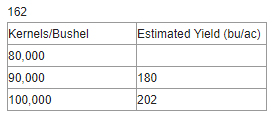By the OMAFRA Field Crop Team
Pre-Harvest Corn Yield Estimates and Late Season Corn Scouting
It’s the beginning of September and the growing season is on the final stretch. Perhaps you’re impatient and can’t wait until harvest to get an idea of what your corn yield is looking like. How do you come up with a pre-harvest corn yield estimate? And while you are out there, what else could you be looking at in your corn field?
The corn yield estimate method most commonly used in the crop industry is the Yield Component Method (Nielsen, 2018). Essentially, we are trying to estimate how many kernels per acre might be in our field, multiply the number of kernels by an estimated kernel weight, and use that number to estimate grain yield.
We usually start with a known length of row. For easy math, 1/1000th of an acre is a good place to start, which for 30” corn rows are 17’ 5”. You can carry a tape measure, or for a quick method, some employ the “boot calibration”. My boots are about 13”, so my 17’ 5” is 16 boots and a toe.
Next, we determine how many ears are in that known length of row. Count the number of regular sized ears in that stretch. If you counted 30 ears in 1/1000th of an acre, we would estimate there to be about 30,000 ears/acre in that field based on that section of row.
Next, we must estimate the number of kernels per ear. For time sakes, we don’t usually count every ear, but get a sub sample of ears representative of the sample. Some randomly select an ear from every 4 or 5 plants while others do an “Olympic” average, throwing out the smallest and largest extreme ears and count a subset of the remaining ears.
If we have selected 6 ears from our subset, the quickest way to estimate kernels per ear is to count the kernels round and multiply it by kernels in length. Typically avoid counting the first couple sets of kernels at the base and tip of the ear if those kernels are not representative or fully formed. Incomplete pollination or kernel abortion may prevent full kernel formation across all rows of the ear. If our average ear size based on above was 18 rows of kernels around and 30 kernels in length we would estimate 540 kernels per ear.
Multiplying our ear count (30,000 ears/ac) by our kernel count (540 kernels/ear) gives us an estimated 16,200,000 kernels per acre. For final yield in bu/ac, we must convert kernel count by an estimated kernel count per bushel. Of course, the challenge is we don’t know true kernel weight until harvest, so we must make an estimate. A range of numbers often used in the corn belt is 80,000 for heavy kernel weight expectations, 90,000 for medium kernel weight expectations, or 100,000 for light kernel weight expectations (Nielsen, 2018). Doing a calculation for all three scenarios from the above example may give a general range in potential yields (Table 1).
Table 1. Yield estimate for various kernel bushel counts

Because of field variability, it’s a good idea to repeat these measurements several times throughout a corn field.
Pre-harvest yield estimates are also a great excuse to get out and do some late season scouting in your corn fields as well. Scouting at this time of year can provide follow-up for various in-season management strategies:
Nitrogen – What is the nitrogen status of your plants during grain fill? Higher soil nitrate levels in the spring and below average precipitation late spring and early summer suggested 2018 may be a less responsive nitrogen year in many areas. What do your corn plants look like? If corn leaves show minimal N stress, would you have room to cut back, or at least leave some lower rate strips out in a future year like this to verify if that is the right decision on your farm? If you did cut rate or leave some rate strips out, what do they look like?
Leaf Diseases – What is the leaf disease status in your fields? Leaf disease severity is a major driving factor for whether there may be a yield response to foliar fungicides in grain corn. Severity can depend strongly on hybrid tolerances, weather and cropping practices (rotation, residue). Predicting whether there will be significant leaf disease pressure when making an application at tassel timing can be a challenge, risk factors can aid in making management decisions. Do you have certain hybrids or fields which consistently show lower or higher risks for leaf diseases this time of year?
Western Bean Cutworm – Scouting prior to harvest can provide an opportunity to evaluate Western Bean Cutworm feeding damage. What are damage levels like and how does damage relate to earlier season scouting?
Ear Moulds – Scouting early prior to harvest can provide a heads up on relative ear mould levels and risks by fields, which may allow time for any necessary harvest or grain handling management decisions.
Source : fieldcropnews